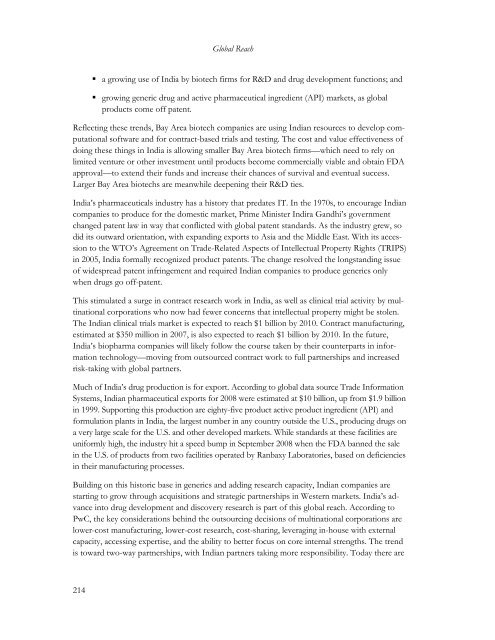PDF: 2962 pages, 5.2 MB - Bay Area Council Economic Institute
PDF: 2962 pages, 5.2 MB - Bay Area Council Economic Institute
PDF: 2962 pages, 5.2 MB - Bay Area Council Economic Institute
Create successful ePaper yourself
Turn your PDF publications into a flip-book with our unique Google optimized e-Paper software.
Global Reach<br />
• a growing use of India by biotech firms for R&D and drug development functions; and<br />
• growing generic drug and active pharmaceutical ingredient (API) markets, as global<br />
products come off patent.<br />
Reflecting these trends, <strong>Bay</strong> <strong>Area</strong> biotech companies are using Indian resources to develop computational<br />
software and for contract-based trials and testing. The cost and value effectiveness of<br />
doing these things in India is allowing smaller <strong>Bay</strong> <strong>Area</strong> biotech firms—which need to rely on<br />
limited venture or other investment until products become commercially viable and obtain FDA<br />
approval—to extend their funds and increase their chances of survival and eventual success.<br />
Larger <strong>Bay</strong> <strong>Area</strong> biotechs are meanwhile deepening their R&D ties.<br />
India’s pharmaceuticals industry has a history that predates IT. In the 1970s, to encourage Indian<br />
companies to produce for the domestic market, Prime Minister Indira Gandhi’s government<br />
changed patent law in way that conflicted with global patent standards. As the industry grew, so<br />
did its outward orientation, with expanding exports to Asia and the Middle East. With its accession<br />
to the WTO’s Agreement on Trade-Related Aspects of Intellectual Property Rights (TRIPS)<br />
in 2005, India formally recognized product patents. The change resolved the longstanding issue<br />
of widespread patent infringement and required Indian companies to produce generics only<br />
when drugs go off-patent.<br />
This stimulated a surge in contract research work in India, as well as clinical trial activity by multinational<br />
corporations who now had fewer concerns that intellectual property might be stolen.<br />
The Indian clinical trials market is expected to reach $1 billion by 2010. Contract manufacturing,<br />
estimated at $350 million in 2007, is also expected to reach $1 billion by 2010. In the future,<br />
India’s biopharma companies will likely follow the course taken by their counterparts in information<br />
technology—moving from outsourced contract work to full partnerships and increased<br />
risk-taking with global partners.<br />
Much of India’s drug production is for export. According to global data source Trade Information<br />
Systems, Indian pharmaceutical exports for 2008 were estimated at $10 billion, up from $1.9 billion<br />
in 1999. Supporting this production are eighty-five product active product ingredient (API) and<br />
formulation plants in India, the largest number in any country outside the U.S., producing drugs on<br />
a very large scale for the U.S. and other developed markets. While standards at these facilities are<br />
uniformly high, the industry hit a speed bump in September 2008 when the FDA banned the sale<br />
in the U.S. of products from two facilities operated by Ranbaxy Laboratories, based on deficiencies<br />
in their manufacturing processes.<br />
Building on this historic base in generics and adding research capacity, Indian companies are<br />
starting to grow through acquisitions and strategic partnerships in Western markets. India’s advance<br />
into drug development and discovery research is part of this global reach. According to<br />
PwC, the key considerations behind the outsourcing decisions of multinational corporations are<br />
lower-cost manufacturing, lower-cost research, cost-sharing, leveraging in-house with external<br />
capacity, accessing expertise, and the ability to better focus on core internal strengths. The trend<br />
is toward two-way partnerships, with Indian partners taking more responsibility. Today there are<br />
214








